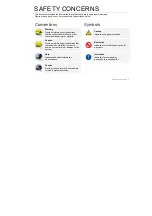
3.00 System Description
The system can consist of one, two, or three
shelves (Basic and Expansion 1, 2) and
Attendant Console. Each shelf contains its own
power supply.
Basic shelf is always required and it can be
equipped with up to 96 lines (including
Extensions and CO lines).
Building Block System
Useful to enlarge system's ability by installing the
optional Expansion Shelf.
Up to two Expansion Shelves can be installed to
the system.
Each expansion shelf can be equipped with up to
120 lines (including Extensions and CO lines).
Flexible Ports
Up to 336 lines (including Extensions and CO
lines) can be connected with this system.
However Extensions (including DSS
consoles)must be 288 lines or less and CO lines
must be 144 lines or less.
Up to two Attendant Consoles (option-with CRT
display) can be connected to the system if ATLC
card is equipped with this system.
Attendant Console can be used for call
processing and system programming in
interactive format.
Switched Loop Attendant Console Operation
makes the handling of incoming calls more
efficient than conventional system.
Starting up the System Administration and
Maintenance of this system can be done using
VT220 (VT100), Compatibles, Dumb terminal or
Attendant Console.
Not only Panasonic Proprietary Integrated
Telephones (PITS) but Single Line Telephones
(SLT) can be used as Extension Telephones in
this system.
4.00 Communications Needs
To meet the user’s communications needs, this
system provides the following features.
Outgoing Call Features
Toll Restrictions allow the manager to restrict
extension users from making certain types of
calls.
Restriction is administered through outward
restriction, toll restriction, and ARS restriction.
Automatic Route Selection (ARS) provides for
the routing of calls over the telecommunication
network based on preferred routes (normally the
least expensive route available at the time the
call is made) with capacity for multiple common
carriers. (for U.S.A., Canada and New Zealand)
Receiving Features
Direct Inward Dialing (DID) allows outside parties
to reach specific inside parties or facilities by
direct dialing without attendant assistance.
Direct Inward System Access (DISA) allows the
outside parties to dial directly into this system
and access to certain system’s features and
facilities without attendant assistance.
After gaining access to the system, the outside
party can access certain system's features by
dialing the appropriate feature number.
Uniform Call Distribution (UCD) allows incoming
calls to be distributed uniformly to a specific
group of extensions. Calls to a UCD group hunt
for an idle extension in a circular way, starting at
the extension following the last one called.
Intercept Routing-No Answer allows calls that are
not answered within a specified time set period to
be redirected to an individual covering extension
and/or an attendant console.
Station Hunting provides automatic redirection of
incoming calls to pre-assigned extension of a
hunting group in a circular way or one way when
the called party is busy.
1-A-3
Summary of Contents for KX-T336
Page 2: ......
Page 4: ......
Page 10: ......
Page 11: ...Section 1 System Outline ...
Page 12: ......
Page 23: ......
Page 49: ...Section 2 Installation ...
Page 50: ......
Page 54: ......
Page 83: ......
Page 113: ......
Page 117: ......
Page 136: ......
Page 146: ......
Page 162: ......
Page 171: ...Section 3 System Features and Operation ...
Page 172: ......
Page 176: ......
Page 183: ......
Page 198: ......
Page 300: ......
Page 403: ...Section 4 Station Features and Operation Proprietary Integrated Telephone System PITS ...
Page 404: ......
Page 418: ...4 A 10 Programmable Feature buttons F1 F2 F3 TRANSFER PF01 PF02 PF03 ...
Page 424: ...Location Type 20 50 1 VOLUME Control 2 RINGER Volume Selector 3 MEMORY Switch 4 A 16 1 2 3 ...
Page 579: ...Section 5 Station Features and Operation Single Line Telephone SLT ...
Page 580: ......
Page 618: ......
Page 624: ......
Page 643: ......
Page 654: ......
Page 671: ......
Page 676: ......
Page 677: ...Section 6 Station Features and Operation Attendant Console ATT ...
Page 678: ......
Page 682: ......
Page 757: ......
Page 787: ......
Page 808: ......
Page 810: ......
Page 812: ......
Page 813: ...Section 7 Preparation for Programming and Maintenance VT220 and Compatibles ...
Page 814: ......
Page 877: ...Section 8 Preparation for Programming and Maintenance Dumb Type Terminal ...
Page 878: ......
Page 907: ...Section 9 System Programming VT220 and Compatibles ...
Page 908: ......
Page 912: ......
Page 1009: ......
Page 1014: ......
Page 1127: ...Section 10 System Programming Dumb Type Terminal ...
Page 1128: ......
Page 1160: ......
Page 1170: ......
Page 1219: ......
Page 1229: ......
Page 1241: ......
Page 1289: ......
Page 1293: ...Section 11 System Programming Proprietary Integrated Telephone System PITS ...
Page 1294: ......
Page 1296: ......
Page 1321: ...Section 12 Station Programming Proprietary Integrated Telephone System PITS ...
Page 1322: ......
Page 1324: ......
Page 1360: ...9 00 Charge Management 9 01 Charge Management Outline 12 C 33 70695 ...
Page 1369: ...12 C 42 70695 Examples of SMDR Printout 1 All CO Lines and Account Codes Meter Charge ...
Page 1370: ...12 C 43 70695 2 All Extensions Meter Charge ...
Page 1371: ...12 C 44 70695 3 Each Extension Meter Charge 4 Attendant Consoles Meter Charge ...
Page 1374: ......
Page 1375: ...Section 13 Station Programming Attendant Console ...
Page 1376: ......
Page 1426: ......
Page 1427: ...Section 14 Maintenance VT220 and Compatibles ...
Page 1428: ......
Page 1432: ......
Page 1453: ......
Page 1457: ......
Page 1494: ......
Page 1527: ...Section 15 Maintenance Dumb Type Terminal ...
Page 1528: ......
Page 1547: ......
Page 1567: ...Section 16 Backup Utility On Site ...
Page 1568: ......
Page 1570: ......
Page 1580: ......
Page 1581: ...Section 17 Backup Utility Remote Location ...
Page 1582: ......
Page 1584: ......
Page 1591: ...Section 18 Abbreviations ...
Page 1592: ......
Page 1595: ...Section 19 I n d e x ...
Page 1596: ......
Page 1602: ......
















































